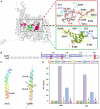A novel major facilitator superfamily-type tripartite efflux system CprABC mediates resistance to polymyxins in Chryseobacterium sp. PL22-22A
- PMID: 38596380
- PMCID: PMC11002906
- DOI: 10.3389/fmicb.2024.1346340
A novel major facilitator superfamily-type tripartite efflux system CprABC mediates resistance to polymyxins in Chryseobacterium sp. PL22-22A
Abstract
Background: Polymyxin B (PMB) and polymyxin E (colistin, CST) are polymyxin antibiotics, which are considered last-line therapeutic options against multidrug-resistant Gram-negative bacteria in serious infections. However, there is increasing risk of resistance to antimicrobial drugs. Effective efflux pump inhibitors (EPIs) should be developed to help combat efflux pump-mediated antibiotic resistance.
Methods: Chryseobacterium sp. PL22-22A was isolated from aquaculture sewage under selection with 8 mg/L PMB, and then its genome was sequenced using Oxford Nanopore and BGISEQ-500 platforms. Cpr (Chryseobacterium Polymyxins Resistance) genes encoding a major facilitator superfamily-type tripartite efflux system, were found in the genome. These genes, and the gene encoding a truncation mutant of CprB from which sequence called CprBc was deleted, were amplified and expressed/co-expressed in Escherichia coli DH5α. Minimum inhibitory concentrations (MICs) of polymyxins toward the various E. coli heterologous expression strains were tested in the presence of 2-128 mg/L PMB or CST. The pumping activity of CprABC was assessed via structural modeling using Discovery Studio 2.0 software. Moreover, the influence on MICs of baicalin, a novel MFS EPI, was determined, and the effect was analyzed based on homology modeling.
Results: Multidrug-resistant bacterial strain Chryseobacterium sp. PL22-22A was isolated in this work; it has notable resistance to polymyxin, with MICs for PMB and CST of 96 and 128 mg/L, respectively. A novel MFS-type tripartite efflux system, named CprABC, was identified in the genome of Chryseobacterium sp. PL22-22A. Heterologous expression and EPI assays indicated that the CprABC system is responsible for the polymyxin resistance of Chryseobacterium sp. PL22-22A. Structural modeling suggested that this efflux system provides a continuous conduit that runs from the CprB funnel through the CprC porin domain to pump polymyxins out of the cell. A specific C-terminal α-helix, CprBc, has an activation function on polymyxin excretion by CprB. The flavonoid compound baicalin was found to affect the allostery of CprB and/or obstruct the substrate conduit, and thus to inhibit extracellular polymyxin transport by CprABC.
Conclusion: Novel MFS-type tripartite efflux system CprABC in Chryseobacterium sp. PL22-22A mediates resistance to polymyxins, and baicalin is a promising EPI.
Keywords: Chryseobacterium sp.; MFS transporter; baicalin; efflux pump inhibitor; polymyxins; resistance.
Copyright © 2024 Zhang, Wang, Qi, Yang, Liu, Ren, Feng, Liu, Cao and Zong.
Conflict of interest statement
MW was employed by Shandong Fengjin Biopharmaceuticals Co., Ltd. The remaining authors declare that the research was conducted in the absence of any commercial or financial relationships that could be construed as a potential conflict of interest.
Figures







Similar articles
-
An efflux pump in genomic island GI-M202a mediates the transfer of polymyxin B resistance in Pandoraea pnomenusa M202.Int Microbiol. 2024 Feb;27(1):277-290. doi: 10.1007/s10123-023-00384-8. Epub 2023 Jun 15. Int Microbiol. 2024. PMID: 37316617 Free PMC article.
-
Pseudomonas aeruginosa MipA-MipB envelope proteins act as new sensors of polymyxins.mBio. 2024 Mar 13;15(3):e0221123. doi: 10.1128/mbio.02211-23. Epub 2024 Feb 12. mBio. 2024. PMID: 38345374 Free PMC article.
-
Drug efflux and lipid A modification by 4-L-aminoarabinose are key mechanisms of polymyxin B resistance in the sepsis pathogen Enterobacter bugandensis.J Glob Antimicrob Resist. 2024 Jun;37:108-121. doi: 10.1016/j.jgar.2024.03.012. Epub 2024 Mar 27. J Glob Antimicrob Resist. 2024. PMID: 38552872
-
Mechanisms of Polymyxin Resistance.Adv Exp Med Biol. 2019;1145:55-71. doi: 10.1007/978-3-030-16373-0_5. Adv Exp Med Biol. 2019. PMID: 31364071 Review.
-
[The role of cell wall organization and active efflux pump systems in multidrug resistance of bacteria].Mikrobiyol Bul. 2007 Apr;41(2):309-27. Mikrobiyol Bul. 2007. PMID: 17682720 Review. Turkish.
Cited by
-
An undergraduate experimental research program, involving the screening of efflux pump inhibitors, to improve student research skills in biomedical science.BMC Med Educ. 2025 May 26;25(1):770. doi: 10.1186/s12909-025-07340-2. BMC Med Educ. 2025. PMID: 40420066 Free PMC article.
-
A reduction-secretion system contributes to roxarsone (V) degradation and efflux in Brevundimonas sp. M20.BMC Microbiol. 2025 Jan 14;25(1):23. doi: 10.1186/s12866-024-03740-4. BMC Microbiol. 2025. PMID: 39810137 Free PMC article.
-
Clinical presentation and outcomes of bloodstream infection with intrinsically carbapenem-resistant non-fermenting gram-negative organisms: Stenotrophomonas maltophilia, Elizabethkingia spp. and Chryseobacterium spp. in Singapore, from 2012 to 2024.BMC Infect Dis. 2025 Feb 25;25(1):273. doi: 10.1186/s12879-025-10636-9. BMC Infect Dis. 2025. PMID: 40000958 Free PMC article.
References
-
- Biovia . (2017) Discovery studio modeling environment, release 2017. San Diego, CA: Dassault Systemes.
LinkOut - more resources
Full Text Sources

